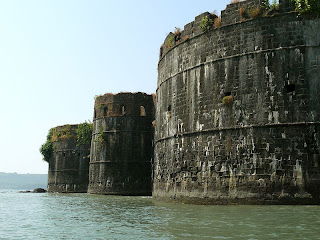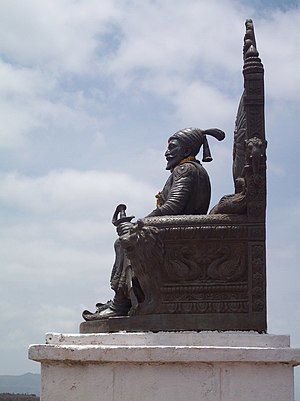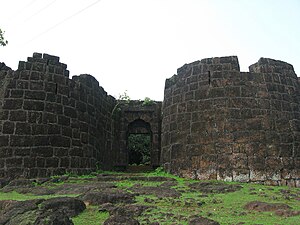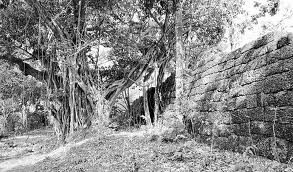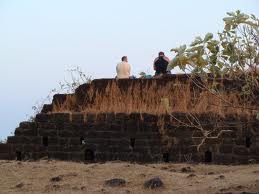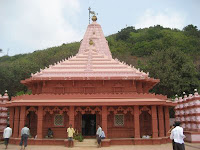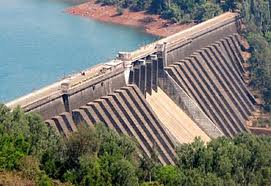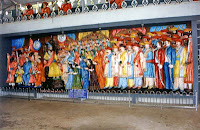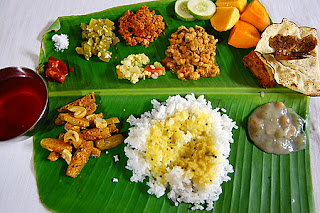History
Background
Until the Konkan Railway started its operations, the two important port cities Mangalore and Mumbai were not directly connected by the railway network. Even though economic reasons provided a strong need to connect these two cities, the region through which the railway track passed was geographically very tough and would be an engineering challenge. Due to the uneven terrain of the region, railway lines were not laid for many years.

Although the brainchild of veteran parliamentarian from Ratnagiri , Manohar Joshi, national leaders such as Madhu Dandawate and George Fernandes, who hailed from the Konkan played a major role in the conception of Konkan Railway. In 1966, a line was constructed between Diva in Mumbai and Apta in Raigad district. During the tenure of Madhu Dandavate, this was extended up to Roha in 1986, mainly to serve the industries located in the area. However, the missing link from Roha to Mangalore still remained. In October 1984, the Ministry of Railways decided to take a final location engineering-cum-traffic survey for the west coastal portion from Mangalore to Madgaon - a total distance of 325 km. In March 1985, the railways decided to extend the scope of their survey to include the omitted length of the west coast line extending from Madgaon to Roha. The Southern Railway was entrusted with this final location survey. They submitted the project report for this route to the Railway Ministry in 1988 and named it as the Konkan Railway after the coastline along which it runs.
The project gained impetus after George Fernandes became the Railway Minister in 1989. It was decided to constitute a separately incorporated railway company for the construction and operation of the line. Thus, on July 19, 1990, the Konkan Railway Corporation Limited (KRCL) was incorporated as a public limited company under the Companies Act, 1956, with its headquarters at CBD Belapur in Navi Mumbai and E. Sreedharan, a senior railway official, as its first Chairman and Managing Director. The company set itself a challenging target of five years to complete the work - something that had never been achieved in India before for a project of this magnitude. The foundation stone for the project was laid at Roha on September 15, 1990, and the Corporation had its task cut out.
Challenges
The 1,319 m (4,327 ft) long Konkan Railway bridge across the Zuari River in Goa. Drawing up their plans in an office, Mr. Sreedharan's team had yet to realise what kind of terrain they would have to battle, and though some surveys had been conducted, there was no data for the entire stretch in Maharashtra- a route which involved half the length of the line. Besides, the task was formidable. With a total number of over 2,000 bridges and 91 tunnels to be built through this mountainous terrain containing many rivers, the project was the biggest and perhaps most difficult railway undertaking during this century, at least in this part of the world. A major challenge in the area was land acquisition. But though land related lawsuits are common in the Konkan, when KRCL began persuading people to give up property that had belonged to their families for generations, many gave it up voluntarily, convinced of the importance of the project. This enabled the entire process to be completed in just a year.
There were challenges posed by the terrain and the elements. Flash floods, landslides and tunnel collapses affected work at many places on the project. The region was also thickly forested, and construction sites were often plagued by wild animals. Despite these problems, work on the project continued, and an effective system of decentralisation enabled better efficiency. The entire stretch of 740 kilometres (460 mi) was divided into seven sectors -Mahad, Ratnagiri north, Ratnagiri south, Kudal, Panji, Karwar and Udupi- of approximately 100 km each, headed by a Chief Engineer.

Contracts for the project were awarded to some of the biggest and most reputed construction firms in India, including Larsen and Tubro, Gammon India and AFCONS. To enable quicker construction, several innovative practices were adopted. Piers for major bridges were cast on the riverbanks itself and launched using cranes mounted on pontoons. The technique of incremental launching of bridge spans was used for the first time in India. Since it would take too long to complete the project using locally available tunneling technology, nine hydraulic tunneling machines were imported from Sweden in order to bore through the hard rock of the Sahayadris. The biggest challenge, however, came from the nine tunnels that had to be bored through soft soil. No technology existed anywhere in the world for this purpose and the work had to be carried out through a painstakingly slow manual process. Excavation was almost impossible due to the clayey soil that was saturated with water owing to a high water table in the region. Several times tunnels collapsed immediately after they had been dug, necessitating work to be redone. Nineteen lives and four years were lost while constructing the soft soil tunnels alone. In all, seventy-four people perished during the construction of the line.
Controversy
Like most other major projects in India, the Konkan Railway was not without its share of controversies. The biggest one arose in the state of Goa, comprising 105 kilometres (65 mi) of the route, where serious concerns were raised about the environmental and economic impact of the line on the state. The opponents to the project stated that the proposed alignment, passing through the coastal regions of the state, would cause destruction of ecology, damage to historical sites and disrupt the lifestyles of people in the densely populated coastal region of the state. In 1991, they came together under and umbrella organisation called the Konkan Railway Re-Alignment Committee (KRRAC) and organised protests against the proposed alignment of the railway line.
The main points raised by the KRRAC were that the existing alignment would cause flooding in coastal regions, destroy the fertile khazan lands, harm the monuments of Goa, cause irreparable damage to the marshes and mangrove swamps along the coastline and estuaries of the Mandovi and Zurari rivers, and result in the large-scale displacement of neighbourhoods along the coastal belt through which it passed. The KRRAC proposed an alternative alignment for the line, known as the hinterland alignment, to offset these problems. The hinterland alignment, passing through the relatively unpopulated hinterland of the state, was to be longer by about 25 kilometres (16 mi), but according to the KRRAC, would significantly minimise the damage caused to the environment.
The hinterland alignment was rejected by the Konkan Railway Corporation on the grounds that it would involve substantial diversion of the line, deny rail access to the major towns of the state, and result in severe delays and escalation of costs of construction. By then, the KRRAC had grown into a political movement, backed by the powerful Church and certain political parties. In March 1992, it filed a public interest litigation in the Bombay High Court, seeking an injunction on the construction work and a diversion of the line through the hinterland alignment. In the plaint , it raised all the issues that had been brought up earlier. The High Court dismissed the plaint in April 1992, observing that the claim of the petitioners that the alignment would have devastating and irreversible impact upon the khazan lands is without any foundation, and even otherwise, the extent of damage is extremely negligible and a public project of such a magnitude which is undertaken for meeting the aspirations of the people on the west coast cannot be defeated on such considerations. It is not open to frustrate the project of public importance to safeguard the interest of few persons. It cannot be over looked that while examining the grievance about adverse impact upon a small area of 30 hectares of Khazan lands, the benefit which will be derived by large number of people by construction of rail line cannot be brushed aside. The Courts are bound to take into consideration the comparative hardship which the people in the region will suffer by stalling the project of great public utility. The cost of the project escalates from day to day and, as pointed out by the Corporation, the extent of the interest and east which will be suffered by the Corporation every day is to the tune of Rs. 45 lakhs. No development is possible without some adverse effect on the ecology and environment.

Completion
Amid all the controversies and problems dogging the project, work continued to progress. In March 1993, the southernmost section of 47 kilometres (29 mi) between Thokur and Udipi in Karnataka was inaugurated, followed by the northernmost section of 47 kilometres (29 mi) between Roha and Veer in Maharashtra in June 1993. The service was extended by 51 kilometres (32 mi) from Veer to Khed in March 1995, and by a further 265 kilometres (165 mi) from Khed to Sawantwadi Road in December 1996. Services on the southern end were extended by 32 kilometres (20 mi) from Udupi to Kundapura in January 1995, and by a further 275 kilometres (171 mi) till Pernem in Goa in August 1997. However, through services between Mumbai and Mangalore continued to remain on hold due to a problematic tunnel at Pernem, which was facing repeated cave-ins and flooding. The tunnel was finally completed in January 1998, six years after its construction had commenced. Through services on the line commenced after a formal inauguration of the entire stretch of 740 kilometres (460 mi) from Roha to Thokur on January 26, 1998. Trains carrying passengers started running along the full route between Mumbai and Mangalore from May 1998. In October 1997, Mr. Sreedharan was asked to take up the responsibility of construction of the Delhi Metro Project.
Organisation
KR does not have divisions like the other Indian Railways; however, it has two regions with headquarters at Ratnagiri in Maharashtra and Karwar in Karnataka. The Ratnagiri region extends over 380 kilometres (240 mi) from Roha to Sawantwadi in Maharashtra, while the Karwar region extends over 360 kilometres (220 mi) from Pernem in Goa to Thokur in Karnataka.
Route
The route is a single-line track, and is not electrified. The total length of the line is about 738 kilometres. Although it has been designed for high-speed traffic of 160 kilometres per hour (99 mph), the fastest train on the route, the Trivandrum Rajdhani Express, at present runs at a maximum speed of 130 kilometres per hour (81 mph). The route is open to both freight and passenger traffic. The line, which runs parallel to the Arabian Sea coastline, offers some of the most spectacular views of any Indian rail journey. The Konkan railway route intersects national highway NH-17 at many places.There are fifty-nine stations on the entire line. Although the route is currently a single line, KR and South Western Railway lines run parallel from Majorda to Madgaon in Goa, making that section a double line.
Operations
Passenger
The route became quite popular with passengers from the day it was opened, due to the connectivity it provided to regions hitherto inaccessible by rail, as well as the substantial savings in time for commuters between western and southern India. Several trains, which earlier took circuitous routes were diverted via the Konkan Railway, leading to a reduction in running time. The first of these was the Mumbai-Kochi Netravati Express, which was diverted via the Konkan Railway from March 1, 1998, followed by the Rajdhani Express to Trivandrum from April 1, 1998. The Mumbai –Mangalore Express was flagged off on May 1, 1998. The Delhi-Kochi Mangala Express was diverted on the route from August 1, 1998. The Pune-Kochi Express was introduced on February 25, 1999. A new train between Kochi and Jaipur via the Konkan Railway began service on October 12, 2001. The Jan Shatabdi Express was flagged off between Mumbai and Madgaon on April 16, 2002, to commemorate 150 years of the existence of Indian Railways . On February 1, 2008, a Garib Rath between Thiruvananthapuram and Mumbai was flagged off. At present, 86 passenger services operate each week in either direction.
Freight
Freight response to the Konkan Railway was lukewarm, prompting the worried corporation to consider cutting rates. With an outstanding debt of Rs. 3,375 crore, KRCL was banking on freight traffic to bail it out. In an effort to attract freight traffic, the corporation began creating awareness among local industries on the route. In 1999, the corporation introduced the Roll On Roll Off (RORO) service, a unique road-rail synergy system, on the section between Kolad in Maharashtra and Verna in Goa, which was extended up to Surathkal in Karnataka in 2004. The RORO service, the first of its kind in India, allowed trucks to be transported on flatbed trailers. It was highly popular, carrying about 1.6 lakh trucks and bringing in over Rs.120 crore worth of earnings to the corporation till 2009.
Difficulties
The hostile terrain and difficult weather conditions of the Konkan region resulted in problems continuing to dog the line even after its inauguration. The first problems surfaced during the monsoon of 1998, when torrential rainfall caused landslides at many places, washed away tracks and disrupted services. Despite the corporation's efforts at addressing the problems through engineering measures such as protective netting along cuttings to prevent boulders from rolling onto the tracks, the problems continued to recur each year.
The first major accident on the line occurred on the night of June 22, 2003, when a landslide caused an express train travelling from Karwar to Mumbai to derail at the entrance to a tunnel. Fifty-one people died as a result of the accident, and several others were injured. As a result of the accident, the corporation came under heavy criticism for failing to adhere to adequate safety measures in the landslide-prone region. An inquiry revealed the cause of the accident to be a failure of a cutting due to absence of monsoon patrolling. The findings were disputed by the corporation, which insisted that the lack of monsoon patrolling did not lead to the accident which was entirely a result of the forces of nature. Shortly after the accident, the corporation announced that it would enhance safety measures on the route.
Barely a year later, these measures were found to be inadequate when a second major accident occurred on the line on June 16, 2004. The Matsyaganda Express bound to Mumbai from Mangalore derailed and fell off a bridge after colliding with boulders on the tracks, killing 14 people. Again, the corporation insisted that the mishap was a result of nature's fury. After the accident, questions were raised about the safety and credibility of the Konkan Railway, prompting the resignation of its director Rajaram Bojji on August 31, 2004.[ An enquiry by the Commissioner of Railway Safety revealed the cause of the accident to be due to "falling of boulders and earth" on the tracks. After the report, the corporation swung into action, implementing all its recommendations, including limiting the speed of trains during the monsoon to 75 km/h (47 mph) as opposed to the regular speed limit of 120 km/h (75 mph), as well as undertaking several geo-technical engineering works, including boulder netting, shotcreting, rock bolting, micropiling and vetiver plantations along the line to increase safety.

Overview Type: Regional Rail
Status Operational Locale: Konkan, India
Termini Roha, Thokur
Stations 59 Operation
Opened 26 January 1998
Owner Government of India Operator(s) Konkan Railways Corporation

Depot(s)
VernaTechnical Line length 738 km
Track length 738 km
No. of tracks 1 Track gauge 1676 mm (5 ft 6in) (broad gauge)
Electrification None
Operating speed 160 km/h (99 mph)
If you like this please Link Back to this article...

